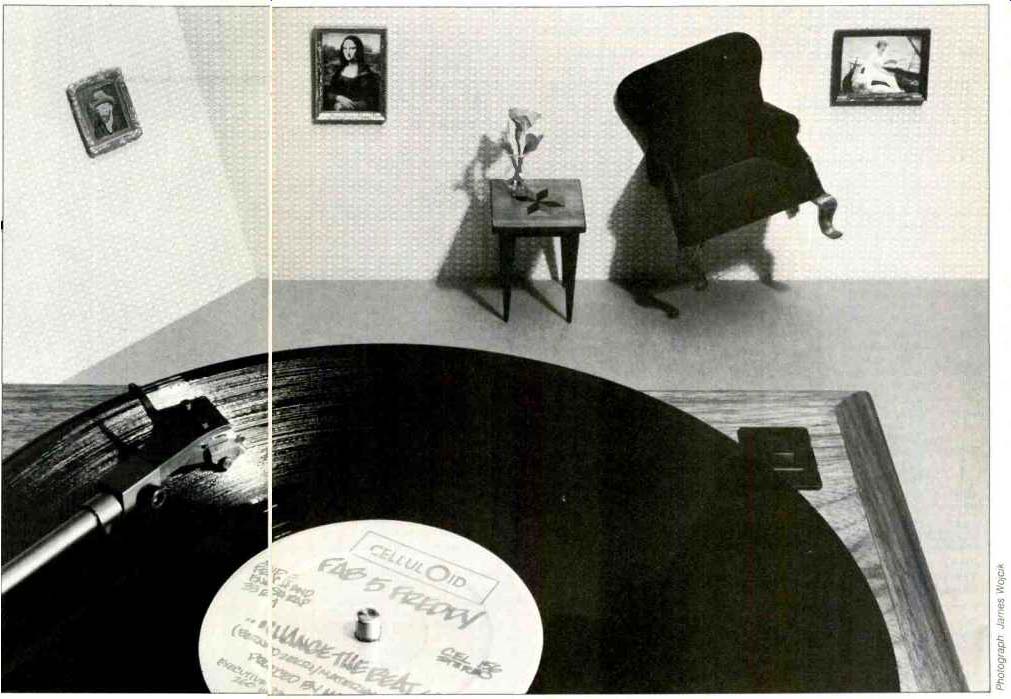
by Robert Kita
[Robert Kita is Implementation Section Manager, Shure Brothers Incorporated, in Evanston, Ill. USA]
To the casual observer of the audio scene, it may seem as it everything that could be done to improve the familiar phonograph, has been done. Each year brings product announcements that portray ever higher levels of audio performance. In particular, one of the most important elements of the stereo playback system, the phono cartridge, has undergone especially significant change in the last several years. Current cartridge models are so much improved they almost beg to be challenged.
The many product claims in evidence make one wonder if there couldn't be a way for an audiophile to prove, in simple terms, just which phono cartridges are really better. It should be easy to get the equipment.
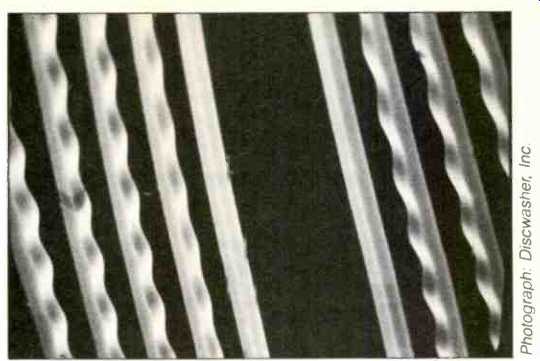
The comparison method should be straightforward to use and interpret.
About two years ago, Shure introduced a new performance concept, the Total Trackability Index (TTI), specifically developed to address this issue. The TTI is a scale on which phono cartridge performance can be graded in a rational way. The audiophile need only have a phonograph record containing the tests and instructions (Shure TTR-117) and a good-quality stereo playback system to obtain the TTI number.
The TTI is based on two factors, the Trackability Factor (TF) and the Indentation Factor (IF). The TF is a measure of the dynamic properties of a phono cartridge or how well it reproduces complex audio signals. The IF accounts for the amount of tracking force used and the stylus tip contact geometry, both of which relate to record wear.
When the two factors are multiplied, they yield (TF x IF = TTI), a total trackability performance number. Phonograph cartridges with high TTI numbers most faithfully reproduce what is on the record, while at the same time producing minimal wear. The TTI for a particular phono cartridge can be compared directly with the TTI for any other. It should be pointed out that the trackability concept is not the only factor which describes phonograph cartridge performance. However, as Shure has been stating for many years, it is without question the single most significant factor.
Trackability Factor
Let's look more closely at part of the TTI, the Tracking Factor (TF), and how it's obtained.

above: Scanning electron micrograph of a spherical stylus tip of 0.7-mil
radius in an actual record groove. Photograph: John L. Brown, Georgia Institute
of Technology.
In its most basic form, perfect track ability requires that the stylus tip never leave the record groove wall surface. It is a known fact that mistracking occurs when the tip lifts away from the groove wall. An equally unacceptable condition exists when the tip leaves the desired path along the groove wall surface and is pressed into the groove wall by excessive inertial forces. This action causes temporary or, more seriously, permanent groove deformation, which the listener perceives as subtle or even very noticeable distortion. Permanent groove deformation is observed as record wear or damage, resulting in an irreversible increase in surface noise and distortion.
It is important to note that if stylus trackability at a specific tracking force can be increased, there will be a corresponding reduction in audible distortion and wear effects. The factors that increase trackability also increase the useful life of the stylus tip. It is always true that higher trackability goes hand in hand with decreased dynamic force appearing at the stylus tip-groove interface.
To gain further understanding of these concepts, consider Fig. 1, which shows trackability requirements displayed in graphic form. The plotted curve relates frequency to the highest level a cartridge must accurately reproduce. In the figure, the portion of the audio spectrum from 100 Hz to 20 kHz is shown on the horizontal scale.
The vertical scale represents peak recorded velocity or loudness, and extends from 1.0 cm/S, for a very quiet sound, up to 100 cm/S, an extremely loud recorded sound.
The full range of the audible spectrum must be included in any fair evaluation of a phono cartridge. After all, the variety of musical programs available today does utilize that spectrum more fully than ever before. The scattered pattern of circles is illustrative of the range of recorded signals to be found. Each circle represents a velocity and frequency value taken from an individual laboratory measurement of a commercial record. Measured signals from many records are shown in the graph, which represents the trackability challenge of modern phonograph records.
Early laboratory measurements of trackability were obtained by observing stylus behavior for calibrated signals. These were usually single tones and gave a trackability reading at one frequency in the audible spectrum. We have provided this specification data on our phonograph cartridges since the mid-'60s, and the data is very useful in comparing the performance of these cartridges. To be able to graphically portray the trackability performance of a cartridge across the audible spectrum requires the tabulation of readings taken at many velocities and frequencies. In the engineering lab, there is much value in obtaining a complete plot of this kind; it would not be practical for an audiophile to collect, plot, and interpret all of this data.
To allow the audiophile to deal with this problem, a more direct approach has been devised that produces accurate results suitable for comparisons.
In this approach, the audio spectrum is divided into three segments, as shown in the lower part of Fig. 1.
The low-frequency region, below 1 kHz, contains recorded signals having large amplitudes, which call for large deflections of the stylus or high compliance. The mid-frequency region is populated with high signal velocities that necessitate a limited degree of stylus damping for good control.
Above 8 kHz are the high-frequency signals, which are small in amplitude but occur very rapidly. It is these tiny, energy-rich signals that impart intense accelerations to the stylus and give the effective mass of the stylus such great significance.
The trackability test signal has three parts, each one representing a segment of the full spectrum. Sine waves at 200 Hz, 2.1 kHz, and 17 kHz are used together to explore the low-, mid-, and high-frequency regions simultaneously. As the cartridge attempts to reproduce the composite signal, its three major characteristics-compliance, damping, and effective stylus mass properties-are simultaneously challenged.
An important decision that was made concerns the recorded velocity or loudness at which the composite trackability signal is presented. The Tracking Factor should imply a degree of trackability excellence with respect to a reference level of some kind. To establish this reference, a trackability curve for an ideal high-performance cartridge was drawn on a graph of known high-level recorded signals (Fig. 1). All the circles, or measured signals from records, are encompassed by this curve. The curve was based on the trackability the ideal cartridge should have at each frequency to faithfully reproduce all of these signals. This curve is called the envelope of measured signals. The envelope represents the maximum trackability limits of the ideal phono cartridge if it were measured just one frequency at a time.
To best reproduce the measured signals within the curve, the trackability designed into the ideal cartridge should have the same proportions (at low, mid, and high frequencies as the envelope indicates.) Therefore, the three-part trackability test signal has its recorded velocity components balanced to agree with the contour of that envelope. The combined velocity level of the three parts must equal that of any one single-frequency signal on the ideal trackability curve. This means that the recorded velocity levels of the three individual parts is about 10 dB below, or one-third the level of, each equivalent point on the ideal curve, as shown in Fig. 2.

Table 1--Trackability Factor (TF) as a function of signal level; dB values
are relative to reference level shown, and numbers in bottom line refer to
bands on Shure TTR-117 test record. The 0-dB reference level for the composite
signal is made up of 200 Hz at 3.3 cm/S plus 2.1 kHz at 21 cm/S plus 17 kHz
at 20 cm/S, all peak recorded velocities.
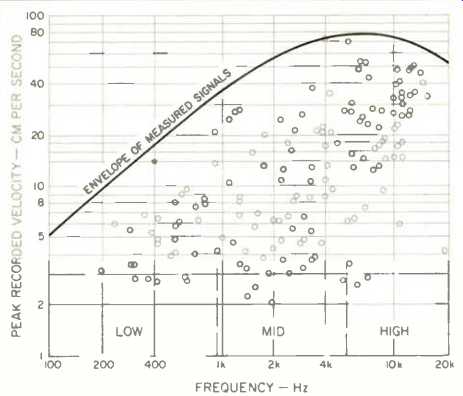
Fig. 1--Measured signal levels from actual recordings (small circles); the
envelope encompassing these measurements shows the maximum individual frequency
tracking requirements for an ideal cartridge.
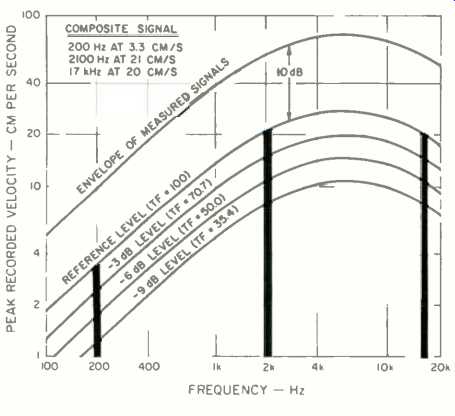
Fig. 2--Recorded levels of the track ability test's low-, mid and high-frequency
signals (reference curve) are 10 dB lower than the measured signal envelope,
so the combined level will equal that of single frequencies on the envelope
curve.
In practice, only a phono cartridge having high overall trackability plus the correct balance between low-, mid-, and high-frequency track-abilities will faithfully reproduce this test signal. For example, a very compliant phono cartridge will not score very well unless the effective stylus mass is sufficiently low to reproduce the 17-kHz signal without breakup. Conversely, a cartridge having a low stylus mass and corresponding high-frequency trackability may not score well if its compliance is not adequate to reproduce the 200-Hz component. Cartridges having a balance of trackability well suited to reproduce the signals under this curve, and do so at a low tracking force, will achieve a high TF. The trackability test signals, available as part of the TTR-117 test record, are recorded at six modulation levels.
The highest level is the reference level just described (see Fig. 2). Faithful reproduction of this level results in a TF of 100. Tracking a signal level of -1 dB, 11% lower in velocity, corresponds to a TF of 89. Trackability signals at -1,-2,-3,-5, and-7 dB below reference are also provided. These trackability test bands, which are sequenced in order of increasing velocity, are played by the cartridge under test. The highest level test band that is reproduced without distortion is used to determine the cartridge's TF from Table 1.
Indentation Factor
The second factor in the TTI equation is the Indentation Factor (IF). While the TF relates to trackability, an additional factor is needed which will quantify distortion due to mild but permanent groove wall deformation.
To understand this relationship, a computer-aided mathematical analysis was conducted to examine the tip groove interface. The degree of indentation of the stylus tip into the vinyl record groove wall was calculated for many combinations of tip geometry and tracking force. An important premise was that the depth of indentation of the tip into the soft vinyl surface is the dominant factor in permanent deformation.
The Indentation Factors calculated in the study were tabulated with respect to tracking force and stylus geometry. From Table II, it can be seen that the IF is a very strong function of tracking force, more so than it is a function of tip geometry. From this relationship, one can appreciate the value of a cartridge that requires only 1 gram for its recommended setting, as compared to another that requires 2 grams or more. A record played with a spherical, 0.0006-inch radius stylus tip will take 100 plays at 1 gram to exhibit as much degradation as it will after only 63 pays with a 2-gram tracking force, assuming no mistracking occurs.
While the primary use of the IF is related to record life, it is also a guide to estimating relative diamond-stylus tip life.
TTI Examples
In the final step, the two factors, TF and IF, are then multiplied to yield the TTI. For example, a cartridge with a hyperelliptical stylus tip shape, measuring 0.0002 inch x 0.0015 inch, has an IF of 1.03 for a tracking force of 1 gram (Table II). If it were to satisfactorily reproduce level 5 of the TTI test signal, it would be given a TF of 89 (Table III):
TTI = TF x IF = 89 x 1.03 = 91.7.
Let's now look at a few numbers for typical cartridges. A moving-coil cartridge with a recommended tracking force of 2 grams, and having a long contact area stylus tip measuring 0.0003 inch x 0.003 inch, has an IF of 0.79. It was able to play level 3 and achieve a TF of 71. This combination results in a TTI of 56, but the cartridge was penalized to some extent because of excess stylus damping, which limits the mid-frequency trackability and necessitates the 2-gram rating.
Another type, an electret cartridge rated at 1 gram, has a 0.0003 inch x 0.0007 inch elliptical stylus tip and an IF of 0.91. It tracked only level 2 at 1 gram and yielded a TF of 56. The TTI for this example is just 51, primarily because of its lack of adequate trackability. The stylus effective mass is high, which causes high-frequency distortion at a low test level.
In Table III, TTI values are shown for several models of Shure V15 cartridges. In each successive model, a significant increase in TTI was achieved. The improvements in track ability and optimization of tip geometry each contributed to the changes.
An important fact to be recognized is that the TTI number is determined with the audiophile's home playback system. The test is conducted under the same conditions normally used to play records. A special measurement setup is not needed. This in situ evaluation will portray performance results individually for each unique combination of equipment.
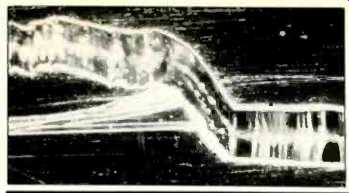
above: A real-world challenge: The cannon shot on Telarc's 1812 Overture.
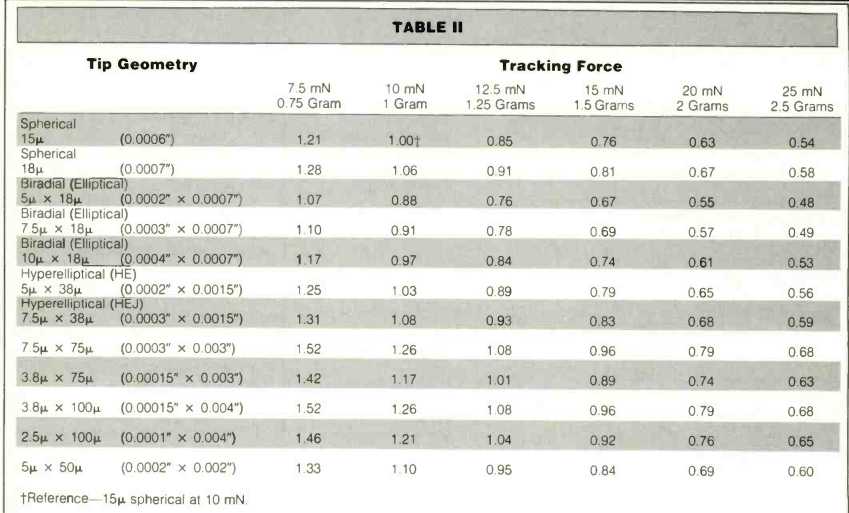
Table II--Indentation Factor (IF) as a function of tracking force and stylus
geometry.
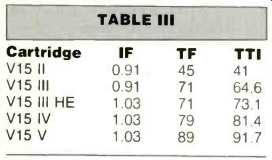
Table III--Total Trackability Index (TTI) is the product of IF and TF. Values
shown here are for five models of Shure V-15 cartridges.
Summary
Using the TTI, the audiophile can compare, on a rational scale, any good-quality phono cartridge, be it a moving-magnet, a moving-coil or an electret type, with any other. This scale combines an evaluation of a cartridge's dynamic properties, stylus tip geometry, and rated tracking force.
The TTI signal is a real challenge and will produce revealing results.
(Editor's Note: Shure's TTR-117 test record is available for $15.00, including postage and handling, directly from Shure Bros., 222 Hartrey Ave., Evanston, Ill. 60204, or some Shure dealers.)
References
1. Kogen, James, "Trackability," Audio, Nov. 1966.
2. Kogen, James, Bernhard Jakobs, and Frank Karlov, "Trackability1973," Audio, Aug. 1973.
3. Mastricola, Scott, "Record Wear," Stereo Review, July 1976.
(Source: Audio magazine, Jan. 1984)
Also see:
= = = =